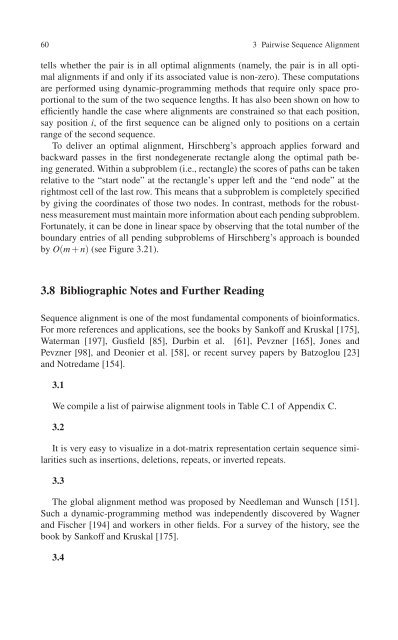Create successful ePaper yourself
Turn your PDF publications into a flip-book with our unique Google optimized e-Paper software.
60 3 Pairwise <strong>Sequence</strong> Alignment<br />
tells whether the pair is in all optimal alignments (namely, the pair is in all optimal<br />
alignments if and only if its associated value is non-zero). These computations<br />
are performed using dynamic-programming methods that require only space proportional<br />
to the sum of the two sequence lengths. It has also been shown on how to<br />
efficiently handle the case where alignments are constrained so that each position,<br />
say position i, of the first sequence can be aligned only to positions on a certain<br />
range of the second sequence.<br />
To deliver an optimal alignment, Hirschberg’s approach applies forward and<br />
backward passes in the first nondegenerate rectangle along the optimal path being<br />
generated. Within a subproblem (i.e., rectangle) the scores of paths can be taken<br />
relative to the “start node” at the rectangle’s upper left and the “end node” at the<br />
rightmost cell of the last row. This means that a subproblem is completely specified<br />
by giving the coordinates of those two nodes. In contrast, methods for the robustness<br />
measurement must maintain more information about each pending subproblem.<br />
Fortunately, it can be done in linear space by observing that the total number of the<br />
boundary entries of all pending subproblems of Hirschberg’s approach is bounded<br />
by O(m + n) (see Figure 3.21).<br />
3.8 Bibliographic Notes and Further Reading<br />
<strong>Sequence</strong> alignment is one of the most fundamental components of bioinformatics.<br />
For more references and applications, see the books by Sankoff and Kruskal [175],<br />
Waterman [197], Gusfield [85], Durbin et al. [61], Pevzner [165], Jones and<br />
Pevzner [98], and Deonier et al. [58], or recent survey papers by Batzoglou [23]<br />
and Notredame [154].<br />
3.1<br />
We compile a list of pairwise alignment tools in Table C.1 of Appendix C.<br />
3.2<br />
It is very easy to visualize in a dot-matrix representation certain sequence similarities<br />
such as insertions, deletions, repeats, or inverted repeats.<br />
3.3<br />
The global alignment method was proposed by Needleman and Wunsch [151].<br />
Such a dynamic-programming method was independently discovered by Wagner<br />
and Fischer [194] and workers in other fields. For a survey of the history, see the<br />
book by Sankoff and Kruskal [175].<br />
3.4

















